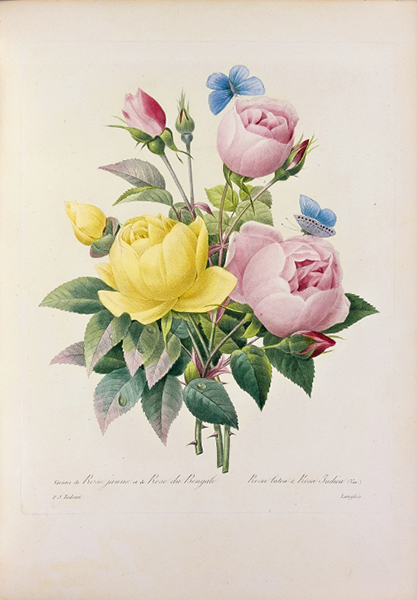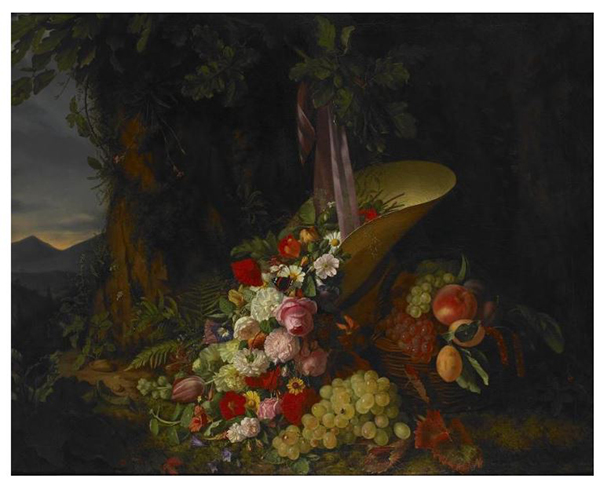Pierre-Joseph Guérou
Download PDFBorn in 1818.
A painter of flowers, Pierre-Joseph Guérou perpetuates a difficult art to which Pierre-Joseph Redouté, "the Raphael of flowers", had given its nobility in the Age of Enlightenment, both by the illustration of the most important botanical textbooks, and by painting. Classified as a minor genre of painting, landscape becomes a noble and grandiose subject with the romantics. Thus, in 1849, George Sand had seen Delacroix "in ecstasy in front of a yellow lily whose beautiful architecture he had just understood" (La Revue des Deux Mondes, June 1, 1860). The painting of flowers is thus revalued by this poetic sensibility, and invades the interiors decoration. It is also not uncommon for small merchants to commission flower paintings from young bohemians for their clientele.
A member of the 1830s youth, which had turned to painting, engraving and literature in France, Pierre-Joseph Guérou appeared for the first time when he was only 18 in 1836, for having proposed two Watercolors at the annual painting Salon, a Carnation Study and a Hollyhock. Guérou is indeed from the generation growing up in the romantic years, like Théodore Chassériau or Gustave Courbet, where reigns the cult of Nature. Thus, he might have wished to follow the footsteps of Simon Saint-Jean, the young painter who in 1833 had made a great impression with Flowery Hat, flowers and fruits, a still life where a bouquet of flowers was staged in a landscape.
Gifted in the reproduction of flowers, Guérou probably earned his living as a porcelain painter for about ten years and was finally employed by the famous Sèvres Manufactory as a "flower painter" between 1847 and 1848. Far from being reserved only for secondary talents, porcelain workshops received the most promising brushes, as was the case of Auguste Renoir employee of Lévy Frères in his youth.
In the year 1849, Guérou sent two porcelain paintings to the annual Salon of the Tuileries Palace, Bouquet of Flowers and Flowers and Fruits. The exhibition opens on June 15, and it is perhaps there that Julien-Nicolas Rivart prospects to find a collaborator in porcelain decoration. The latter registered on next September 18th a patent for a new method of inlaying porcelain in wood and in all other types of materials. Shortly afterwards, Pierre-Joseph Guérou was his collaborator in a bold and successful undertaking, the Rivart porcelains enjoying great enthusiasm.
In particular, he signed the flowers adorning Empress Eugénie’s Jewel Case, which she bought after the World’s Fair of 1855 , and is today kept at the National Museum of the Chateau of Compiègne. In 1852, he painted the inlays of a table preserved in the Murska Sobota Museum (Slovenia), then in 1853, those to be inlaid by Tahan in an impressive flat desk, entered in the Marc Maison Gallery collections. The Gallery contributes in a continuous research to identify his various contributions to Rivart’s porcelain inlays, and also identified his signature on a pair of side cabinets, signed 1854.
We can guess the painter Guérou was absorbed in the 1850s by the Rivart adventure, in which he made the most of his art, suddenly stepping from the status of Sevres’ employee to that of craftsman in the service of His Imperial Majesty. Without a trace of him at Sèvres after 1848, and knowing no other painter signing Rivart's incrustations, Pierre-Joseph Guérou is likely to be the painter of a very large part, perhaps the totality, of porcelain inlays.
For Rivart and Guérou, the porcelain flowers, certainly have a poetic, oxymoron interest, which explains their omnipresence. With the Rivart process and Guérou's delicate brush, these innovative decorations immortalize the ephemeral work of nature. Guérou, meanwhile, will take advantage of his experience with Rivart to return to the Salon every year between 1863 and 1866, with paintings of flowers on porcelain. In 1863 he exhibited Flowers and fruits, then Flowers after Saint-Jean in 1864. Finally, in 1865 and 1866, he returned to back his first love with two watercolors, Flowers and fruits, and Peonies, demonstrating his personal attachment to these jewels of nature, as an authentic nineteenth-century painter.
Bibliography
Marc Maison and Emmanuelle Arnauld, Marqueteries virtuoses au XIXe siècle : Brevets d'invention. Rivart, Cremer, Fourdinois, Kayser Sohn et Duvinage, Dijon, Faton, 2012.






















